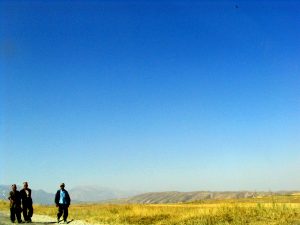In September, long-running Kyrgyz-Tajik border tensions escalated dramatically into a brief open conflict. While the border has quieted again into uneasy tension, it’s difficult to see a path forward under current circumstances. The Kyrgyz-Uzbek border, however, provides a dose of hope.
On September 26, Kyrgyz President Sadyr Japarov welcomed Uzbek Prime Minister Abdulla Aripov to Bishkek for a meeting of government delegations on the final delimitation and demarcation of the Kyrgyz-Uzbek border. During the meeting, head of the Kyrgyz State Committee for National Security Kamchybek Tashiev expressed hope that “in the very near future” the presidents of the two countries would sign a draft agreement resolving the remaining border sections.
A readout of Aripov’s visit from the Kyrgyz presidential office noted that “The parties discussed the upcoming state visit of the President of the Republic of Uzbekistan Shavkat Mirziyoyev to the Kyrgyz Republic.” A specific date has not been announced.
Then on October 4, Japarov traveled to the Uzgen district in Osh region, where the most contentious sections of the Kyrgyz-Uzbek border sit, to meet with residents. The Kempir-Abad reservoir is a particular point of concern. In 2021, Tashiev proclaimed that the Kyrgyz-Uzbek border was “100 percent” resolved, with an agreement stipulating joint use of Kempir-Abad. But the details sparked protest by locals.
As Asel Murzakulova noted in an article for The Diplomat Magazine in September 2021, almost all of the reservoirs in the Kyrgyz-Uzbek border area “are used for the needs of the Uzbek agriculture and energy sectors.” This makes the reservoirs themselves “critically important” to Uzbekistan. “The Kyrgyz government, therefore, has been inclined to abandon some of its claims in exchange for irrigated land or plots of greater strategic value.”
That seems to have been the plan with regard to Kempir-Abad after 2021, with the Uzbek side retaining control of the reservoir and Kyrgyzstan able to access its waters. After protests from locals, negotiations continued between the two sides but Tashiev’s “100 percent” statement aged poorly as a final agreement remains unsigned.
This remains a source of confusion and contention now, as Bishkek and Tashkent continued to push for a final agreement. Following a successful meeting in July in Andijan, Uzbek and Kyrgyz officials gathered in Cholpon-Ata in early August. Later in the month, residents of Uzgen organized and petitioned the government for greater clarity on what had been agreed to in Cholpon-Ata.
Outside Japarov’s recent meeting in Uzgen, villagers reportedly held signs reading “It is better to give life than land!” and “Cancel protocols” among other slogans. Adakhan Madumarov, a member of parliament in the Butun Kyrgyzstan faction, said that locals were concerned that the reservoir would be given to Uzbekistan.
Even as Kyrgyz and Uzbek leaders approach a final agreement, communication and transparency will be critical. Bishkek and Tashkent may agree to lines on a map and terms of use, but it’s the people on the border who have to live the agreement.

































